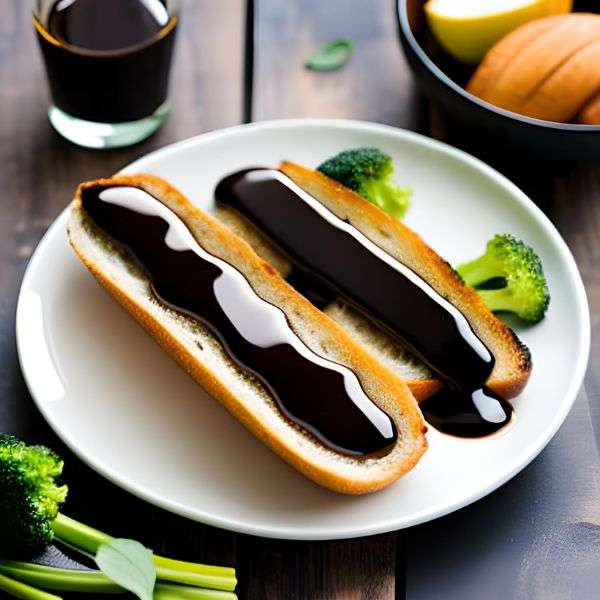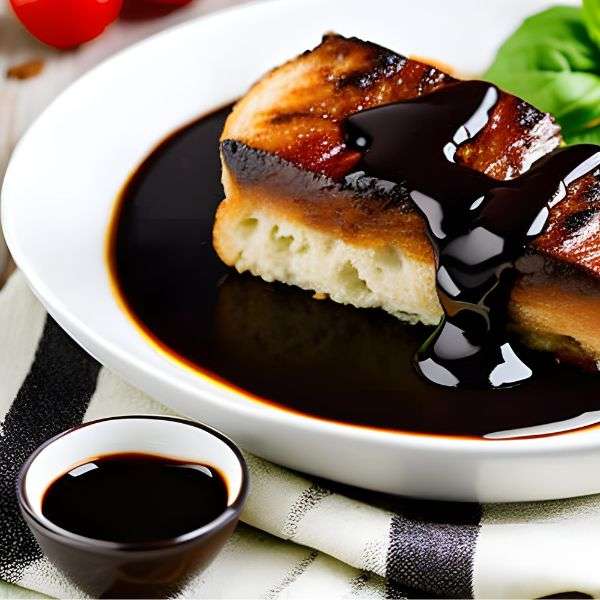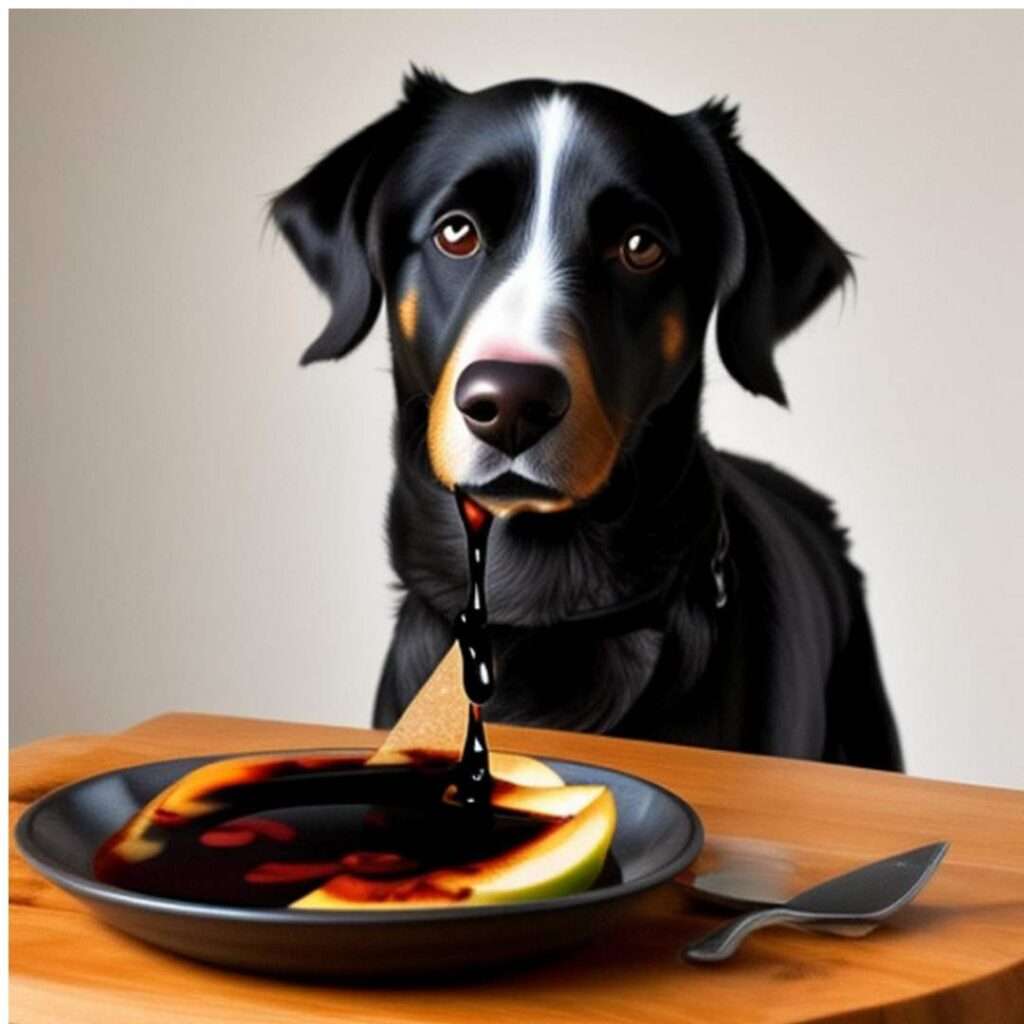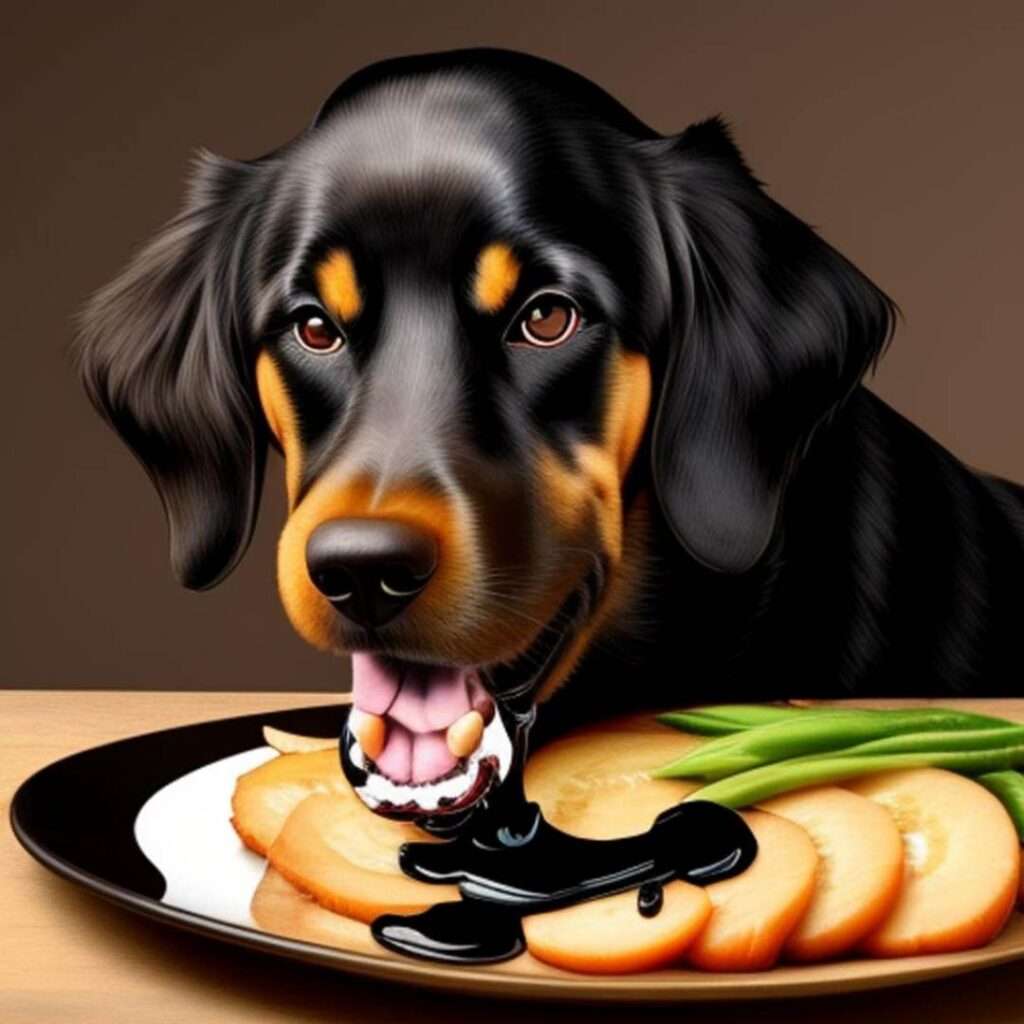Can dogs eat balsamic glaze? The short answer is no, dogs can not eat balsamic glaze as it contains some ingredients that are harmful to dogs.
In this article, we will discuss the health risks of feeding balsamic glaze and suggest some best alternatives for well well-being of dogs. So let’s get into the article!
Understanding Balsamic Glaze
Balsamic glaze, sometimes called balsamic reduction, is simmered balsamic vinegar used in the kitchen to make dishes more delicious. It comes from balsamic vinegar which makes it more tasty and flavourful.

Balsamic vinegar usually originated in Italy and is made by turning grape juice into vinegar. But balsamic glaze makes this special vinegar even more awesome. They simmer and reduce the vinegar to make it thick like syrup and super flavorful.
Can Dogs Eat Balsamic Glaze?
No, dogs cannot eat balsamic glaze. Balsamic glaze contains ingredients such as grapes and onions that can be toxic to dogs.
Also, it has a high sugar and salt content which can cause issues in dogs’ digestive system. It is recommended to keep it away from your dog and choose other healthy foods.
Stick to dog-friendly treats and consult your veterinarian if you suspect your dog has ingested any potentially harmful human foods.
Potential Risk Associated with Balsamic Glaze
Harmful Stuff:
Balsamic glaze often contains grapes and onions, which can be harmful to dogs. Even a small amount of such ingredients can harm dog health and lead to kidney and stomach issues
Too Much Sugar:
Balsamic glaze tastes sweet, but this sweetness comes from a lot of sugar.

High content of sugar can make your dogs gain too much weight, get diabetes, and have dental problems. So, it’s important to avoid feeding balsamic glaze to your dog.
Too Much Salt:
Some balsamic glazes have extra salt to make them taste better. Over consumption of salt is dangerous for dogs, because it can lead to sickness, vomiting, diarrhea, and thirst.
Upset Tummies:
Dogs have sensitive tummies, and eating unfamiliar and rich foods like balsamic glaze can make their tummies hurt, give them gas, and cause diarrhea.
Too Many Calories:
Balsamic glaze has a lot of calories because of the sugar. If dogs eat it often, they could get fat, which makes their joints hurt and causes other health problems.
Allergies:
Some dogs can get allergies to different types of foods. If you feed your dog allergic foods like balsamic glaze, it can cause itching, skin troubles problems, and sometimes even worse reactions.
What to do if a Dog has Eaten Balsamic Glaze?
If your furry friend accidentally eats balsamic glaze, here is guide for you to handle this situation:

Stay Calm: First, you need to stay calm and act as a responsible owner.
Figure Out the Quantity: Figure out how much balsamic glaze your dog ate. This will help when you talk to a vet.
Call the Vet: Get in touch with your vet or an emergency animal hospital right away. Tell them how much your dog ate, what’s in the glaze, and how big your dog is. They’ll tell you what to do.
Watch for Signs: To ensure your dog’s well-being, you have to watch them closely for any unusual behavior or signs of illness. These signs include vomiting, diarrhea, excessive fatigue, a tender abdomen, or changes in urination.
Give Water: Make sure your dog has clean water to drink. This can help get rid of any bad stuff and help their tummy.
Do What the Vet Says: Do whatever your vet tells you. They might say to bring your dog to the vet’s office, give them special things, or just watch them at home.
Keeping Your Dog Safe from Balsamic Glaze
Making sure your dog is safe means taking steps to stop them from getting foods that might hurt them, like balsamic glaze. Here are some ways to help your dog stay away from eating this food:

Lock Up Food: Put balsamic glaze that could be bad for your dog in places they can’t get to, like cabinets. You can even use locks if you need to.
Keep Countertops Clear: Keep your countertops free of food and dishes. You could also use things that make noise or mats that give a little shock to keep them off.
Watch During Meals: If your dog tries to take your food, think about keeping it out of the room when you eat. Give them a special spot or a toy to play with.
Teach “Leave It”: Teach your dog to listen when you say “leave it.” When they do it right, give them treats so they learn it’s important.
Use Gates: Use gates to keep your dog away from certain parts of the house, especially when you’re making food.
Alternatives to Balsamic Glaze for Dogs’ Health
Here are some foods and snacks that can be very safe for your dog instead of feeding them with balsamic glaze.
Carrot Sticks: Carrot sticks are a great choice – they’re crispy, low in calories, and offer a satisfying crunch. Plus, they’re loaded with vitamins and minerals that can benefit your dog’s health.
Apple Slices (Without Seeds): Apples offer a natural sweetness while being a great source of fiber and vitamins. Ensure to remove seeds and core before offering slices.
Blueberries: Blueberries are a tasty and nutritious option for your dog. They’re packed with antioxidants and bite-sized, and you can even freeze them for a cool summer treat.
Plain Cooked Chicken: Cooked, unseasoned chicken is a lean protein source that many dogs love. Cut it into small pieces for a protein-packed treat.
Pumpkin Puree: A spoonful of plain, canned pumpkin (not pumpkin pie filling) is not only delicious but can also help with digestion and provide fiber for your dog.
Plain Yogurt: Full of probiotics and protein, plain yogurt can be an occasional treat. Check for lactose intolerance before introducing this option.
Watermelon Chunks (Seedless): On hot days, offer seedless watermelon chunks for a juicy and hydrating treat that dogs often enjoy
Plain Rice Cake: A plain rice cake can serve as a low-calorie, crunchy treat option for your dog.
FAQs
Can dogs have any type of balsamic glaze?
No, it’s recommended to avoid feeding dogs any type of balsamic glaze. Even small amounts can contain toxic ingredients like grapes and onions, which can be harmful to dogs.
What makes balsamic glaze harmful to dogs?
Balsamic glaze often contains grapes and onions, both of which are toxic to dogs. Additionally, its high sugar and salt content can lead to various health issues.
Are there any safe ingredients in balsamic glaze for dogs?
While the primary ingredients in balsamic glaze are not safe for dogs, you can find safer alternatives among dog-friendly treats and foods specifically formulated for canine consumption.
What should I do if my dog accidentally eats balsamic glaze?
If your dog consumes balsamic glaze, contact your veterinarian immediately. Provide them with details about the ingested amount, ingredients, and your dog’s size for appropriate guidance.
Can a small taste of balsamic glaze harm my dog?
Even a small taste of balsamic glaze can potentially be harmful due to its toxic ingredients and high sugar content. It’s best to avoid giving your dog any amount of balsamic glaze.
What are the symptoms of balsamic glaze ingestion in dogs?
Symptoms can include vomiting, diarrhea, lethargy, abdominal discomfort, changes in urination, and more. If you notice any unusual behavior or symptoms, consult a veterinarian.
Is it safe to feed my dog other types of vinegar?
While some types of vinegar can be safe for dogs in small amounts, it’s always best to consult your veterinarian before introducing any new food items to your dog’s diet.
Conclusion
It’s best to keep balsamic glaze away from your dog and make sure your dog eats healthy food. There are many other healthy options from which you can choose.
This yummy sauce can be good for humans, but not for dogs. Hopefully, you liked our article and learned a lot from it. Now you know if your dog can eat balsamic glaze or not.
So if you want to learn more about other different foods, you can visit our other articles as well to educate yourself about them.
Happy Snacking!
